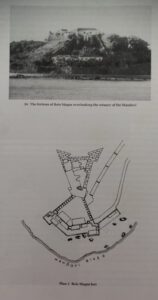On the right bank of the Mandovi, facing Panjim’s river front boulevard at Campal, stand a fort and church called Reis Magos (The Magi), landscaped by red rocks, yellow-green vegetation and a fishing village. The turreted walls and baroque façade in this chromatic setting come out soft in the morning rays, turn awesome at noon, and are a sight to behold when silhouetted by the setting sun or bathed by the moon.
Perched on the south-eastern edge of the Bardez tableland, the citadel was constructed in 1551, enlarged on different occasions, and finally re-erected in 1707. It is now X-shaped with two inner courtyards. Together with Gaspar Dias, its counterpart on the opposite shore, it was meant to provide the second line of defence for the capital should the enemy manage to sail past the Aguada and Cabo forts. Interestingly, the fort that acted as a minor jail until 1993 was where, over a century ago, Madhav Rao, the rajah of Sawantwadi stayed when on an official visit to Goa with a retinue of 1500 men, 1000 horses and 4 elephants.
A perennial nearby spring with abundant potable water catered to the fort; but to nourish the soldiery with “living water” the Franciscans erected a church alongside its walls in 1555. This three-storied edifice (the taluka’s first), with its impressive light of steps, was part of their now extinct mission centre. Their college promoted Konkani studies, and produced eminent churchmen like Dom Matheus de Castro, Goa’s first bishop. It was also there that both viceroys and bishops sojourned prior to assuming office upon their arrival in Goa, or after relinquishing it. Some of them lay buried within the church precincts; the walled parish graveyard nestling on an intermediate level between the church and the fort came much later.

This historic locale, called Verem, is now better known for its annual celebration of the feast of the Epiphany on 6 January. No viceroy, bishop or nobleman now attends; it is only three village boys in gala attire who still play the Magi. They descend from the ramparts (earlier they did it on horseback), carrying their precious gifts and the solemn Mass begins even amidst the din of the traditional fête outside. Only trinkets though they sold- and not gold, frankincense or myrrh in the tradition of the Magi the fair that was once worthy of the fort’s enclosure has now become a roadside affair. But the joy it brings to all that throng to it! What form all these customs will take when the fort turns into a heritage hotel soon, only time will tell!
Banner: https://rb.gy/xjugos
First published in ‘Heritage Point’, Panjim Plus, 1-15 January 2002, p. 6